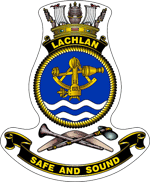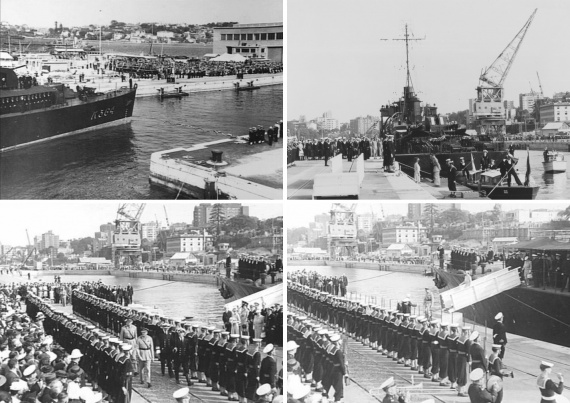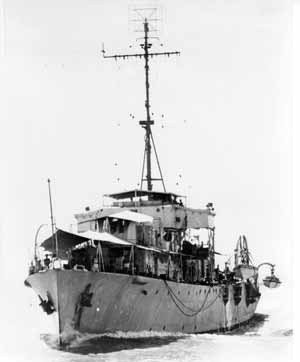HMAS Lachlan
| Class |
River Class |
|---|---|
| Type |
Frigate |
| Pennant |
K364 |
| Builder |
Mort's Dock & Engineering Co Ltd, Sydney |
| Laid Down |
22 March 1943 |
| Launched |
25 March 1944 |
| Launched by |
Mrs Scullin, wife of the former Australian Prime Minister |
| Commissioned |
14 February 1945 |
| Decommissioned |
5 October 1949 |
| Dimensions & Displacement | |
| Displacement |
|
| Length | 301 feet 6 inches |
| Beam | 36 inches 6 feet |
| Draught | 12 feet |
| Performance | |
| Speed | 20 knots |
| Complement | |
| Crew | 140 |
| Propulsion | |
| Machinery | Triple expansion, 2 shafts |
| Horsepower | 5500 |
| Armament | |
| Guns |
|
| Other Armament |
|
| Awards | |
| Battle Honours | |

HMAS Lachlan was ordered as part of Australia's shipbuilding program during the Second World War. Twelve of these Australian built frigates were to enter service with the Royal Australian Navy. A further ten were ordered but cancelled as the war drew to a close.
Eight, HMA Ships Barcoo, Barwon, Burdekin, Diamantina, Gascoyne, Hawkesbury, Lachlan and Macquarie, were built to the British River Class design and Australia likewise named its frigates after Australian rivers. A further four, HMA Ships Condamine, Culgoa, Murchison and Shoalhaven, were also named after Australian rivers but were built to the design of the Royal Navy's Bay Class Frigates. These latter ships were generally known as Modified River Class Frigates although they are sometimes referred to as Bay Class.
Lachlan commissioned at Sydney on 14 February 1945 under the command of Lieutenant Commander George D Tancred DSC RAN.

On 24 March 1945, with the Governor-General and his wife, Their Royal Highnesses the Duke and Duchess of Gloucester embarked, the ship made a ceremonial entry into the new Captain Cook Graving Dock to officially open it by breaking a ribbon stretched across the entrance. This was not the first use of the dock, however, as the aircraft carrier HMS Illustrious had been taken in for emergency repairs earlier in the month.
Although classified as a frigate, in the sense of being one of a class of frigates, Lachlan's entire career as a unit of the Royal Australian Navy consisted of service as a survey vessel.
Following trials and a working up period the ship departed Sydney for the forward area on 28 March 1945. She was attached to a Hydrographic Group of United States Navy forces operating in the Philippines and in mid April 1945, took part in the operations at Mindanao in the central Philippines. Later in the same month she was assigned as a unit of the Minesweeping and Hydrographic group (Task Group 70.5, United States Seventh Fleet) assembled for clearing the way for the assault on Tarakan in North Borneo. Following the landings, which took place on 1 May 1945, Lachlan carried out a detailed survey of Tarakan Roads before proceeding to Morotai where she undertook further survey work.
In June 1945 Lachlan took part in the second phase of the Borneo operations at Brunei Bay. She arrived off the chosen assault beaches three days before the landing was scheduled and commenced sounding and buoying the channel approaches. The following day she entered Brunei Bay and laid more buoys. Her boat party and a United States Beach Scout Team carried out close inshore reconnaissance, laying markers for the assault forces within thirty yards of the beach. Following the landings on 10 June 1945, she carried out more detailed surveys of the area. On her departure from Borneo, Rear Admiral Royal USN, Commander Task Force 78.1, United States Seventh Fleet, signalled ‘I give you the highest naval praise. Well done.'
In August and September 1945, Lachlan was engaged without respite in surveys of the Leyte Gulf area in the Philippines. In October she was surveying in the waters off Biak and Morotai Islands and off the Vogelkop Peninsula. She also served in these areas as a transport for the movement of Japanese prisoners. On 25 November, after further survey duty in New Guinea waters, Lachlan returned to Sydney after an absence of eight months on war service during which she steamed some 21,000 miles.
In February 1946 Lachlan's Bofors guns, Hedgehog, depth charge rails and throwers were removed. Lachlan resumed operations as a survey vessel in March 1946, and thereafter until the end of October 1947 she took part in the extensive post war survey programme in Australian waters initiated in 1946.
On 17 November 1947 the ship arrived at Williamstown Dockyard, Melbourne, to undergo a refit, which was completed at the end of April 1948. During the refit, two Squid mortars and one single Bofors gun were mounted, although the mortars were removed at a later stage. On 25 May 1948 Lachlan sailed for Sydney, where she remained until 17 September 1948 when she sailed for Fremantle.
At Fremantle the ship commenced a further refit and preparations to enter Reserve. However, the transfer to Reserve did not eventuate as it was decided to loan the ship to the Royal New Zealand Navy, and to prepare for the transfer an advance party from the Royal New Zealand Navy joined on 16 May 1949. The main body of the ship's company joined in August.
On 5 October 1949 Lachlan paid off at Fremantle, having steamed 32,737.7 miles since commissioning in the Royal Australian Navy. She commissioned the same day as HMNZS Lachlan under the command of Lieutenant Commander PD Hall DSC RN. Lachlan arrived in Auckland in November 1949.
The period of the loan was initially three years but this was extended several times and in 1962 Lachlan was purchased by the New Zealand Government. The ship's service as a unit of the Royal New Zealand Navy was again as a survey vessel. In February 1975 she paid off for alongside service and later in the year she was deleted from the Navy List.
Further reading
- 'HMAS Lachlan: Making Sea lanes Safer for Navigators, 1945-46' by AE (Ted) Jones, circa 2001.









